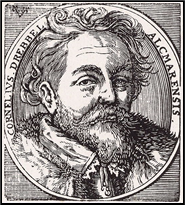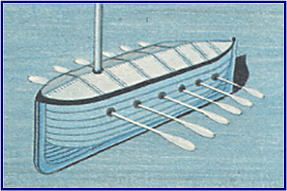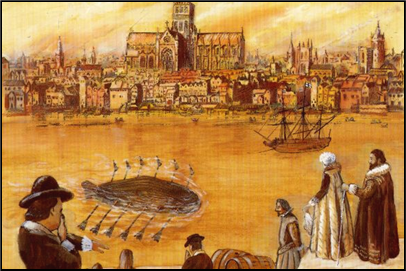


xxxxxThe Dutch inventor Cornelius van Drebbel constructed the first under-water boat in 1620. Built in England he carried out a series of trials on the River Thames, with James I being present on at least one occasion. The vessel was basically a wooden rowing boat encased in oiled leather, and with leather gaskets to seal off the outlets for the oars. Air was supplied by two long tubes, held on the surface of the water by floats. Powered by 12 oarsmen and taking several passengers, it once made the journey from Westminster to Greenwich at a depth of 15 feet. It was almost certainly based on a design put forward by an Englishman, William Bourne, in 1578. It was not until the 1770s (G3a) that the next successful attempt was made at constructing a “submarine”, the work of the American David Bushnell.
CORNELIUS VAN DREBBEL 1572 - 1633 (L1, J1, C1)
Acknowledgements
Drebbel: 1631, artist unknown, illustration from Personalities in the Kingdom of the Netherlands in words and pictures, edited by Hajo Brugmans and H. Holwerda, and published c1936 – private collection. Drawing: date and artist unknown. Trial: by G.H.Tweedale, Royal Submarine Museum, Gosport, England.

 xxxxxThe Dutch scientist and inventor Cornelius van Drebbel constructed his under-water boat - the first of its kind - in 1620. Built in England, he carried out a series of trials on the River Thames over the next four years. James I was present at one of the demonstrations (if not more), and might well have taken a short ride aboard the craft. According to a description of the time, the vessel was a wooden rowing boat encased in oiled leather, and with leather gaskets to seal off the outlets for the oars. It could carry twelve oarsman and several passengers and, so we are told, made the journey from Westminster to Greenwich at a depth of some fifteen feet. The air supply was provided by two long tubes held on the surface of the water by floats, and water was admitted to submerge the vessel, and pumped out to raise it. (Herewith an artist's impression).
xxxxxThe Dutch scientist and inventor Cornelius van Drebbel constructed his under-water boat - the first of its kind - in 1620. Built in England, he carried out a series of trials on the River Thames over the next four years. James I was present at one of the demonstrations (if not more), and might well have taken a short ride aboard the craft. According to a description of the time, the vessel was a wooden rowing boat encased in oiled leather, and with leather gaskets to seal off the outlets for the oars. It could carry twelve oarsman and several passengers and, so we are told, made the journey from Westminster to Greenwich at a depth of some fifteen feet. The air supply was provided by two long tubes held on the surface of the water by floats, and water was admitted to submerge the vessel, and pumped out to raise it. (Herewith an artist's impression).
 xxxxxDrebbel was a glassworker and engraver in his native land, but he came to England in 1604 and soon gained royal patronage. Among inventions attributed to him were a "perpetual motion clock" - activated by changes in atmospheric pressure -, the compound microscope, an improved thermometer, and a thermostatically-controlled furnace. He also made advances in the making of coloured dyes and the production of sulfuric acid. Hisx"diving boat" (pictured here on the Thames) was almost certainly based on a design put forward by an Englishman named William Bourne (1535-1582) in 1578. A mathematician and a writer on naval matters, his prototype envisaged a wooden frame covered with waterproof leather.
xxxxxDrebbel was a glassworker and engraver in his native land, but he came to England in 1604 and soon gained royal patronage. Among inventions attributed to him were a "perpetual motion clock" - activated by changes in atmospheric pressure -, the compound microscope, an improved thermometer, and a thermostatically-controlled furnace. He also made advances in the making of coloured dyes and the production of sulfuric acid. Hisx"diving boat" (pictured here on the Thames) was almost certainly based on a design put forward by an Englishman named William Bourne (1535-1582) in 1578. A mathematician and a writer on naval matters, his prototype envisaged a wooden frame covered with waterproof leather.
xxxxxUnfortunately for Drebbel, he could not develop his "underwater boat" any further. His funds ran out, and he had to abandon the project. A number of various types of craft were invented over the next hundred years, but as we shall see, it was not until the 1770s (G3a) that the next successful attempt was made at constructing a "submarine". The brainchild of the American engineer David Bushnell, it was built to attack British shipping during the American War of Independence.
J1-1603-1625-J1-1603-1625-J1-1603-1625-J1-1603-1625-J1-1603-16225-J1-1603-1625-J1







 xxxxxThe Dutch scientist and inventor Cornelius van Drebbel constructed his under-
xxxxxThe Dutch scientist and inventor Cornelius van Drebbel constructed his under- xxxxxDrebbel was a glassworker and engraver in his native land, but he came to England in 1604 and soon gained royal patronage. Among inventions attributed to him were a "perpetual motion clock" -
xxxxxDrebbel was a glassworker and engraver in his native land, but he came to England in 1604 and soon gained royal patronage. Among inventions attributed to him were a "perpetual motion clock" -

